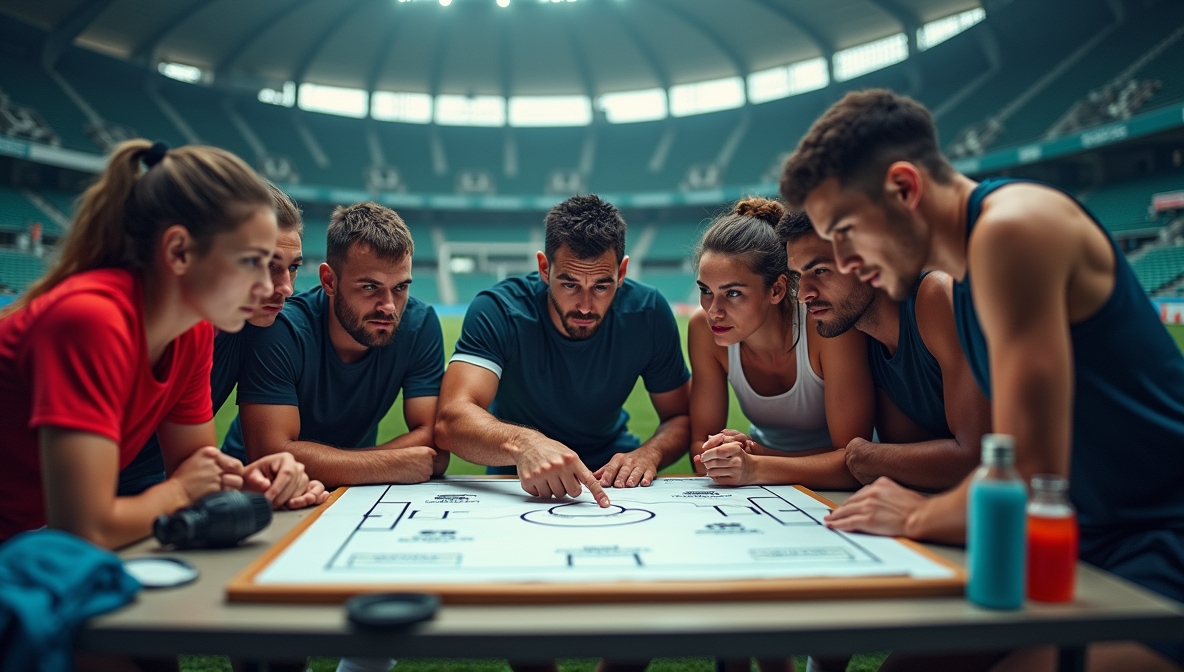Tactical thinking in team sports is the ability to make quick, informed decisions that enhance teamwork and strategy during gameplay. It separates good teams from great ones and can often be the difference between winning and losing. The question is: how can athletes train their minds to excel in strategic situations?
This article explores ways to develop tactical thinking skills, with actionable steps to refine decision-making, improve situational awareness, and strengthen strategic execution on the field or court.
Why Tactical Thinking Matters in Team Sports
Tactical thinking allows athletes to:
- Read the game: Identify patterns, predict opponents’ moves, and adapt strategies.
- Optimize team dynamics: Make decisions that benefit the collective rather than individual performance.
- Improve game intelligence: Understand roles, spacing, and timing to exploit weaknesses in opponents.
Team sports require constant analysis of dynamic situations. Players must balance their immediate actions with long-term strategies, coordinating seamlessly with teammates. Developing tactical thinking can transform these split-second decisions into calculated moves that shift outcomes.
How to Train Tactical Thinking
1. Practice Situational Awareness
Being aware of surroundings during gameplay is critical for making informed decisions. Situational awareness involves observing teammates, opponents, and the environment to anticipate potential outcomes.
Training Tips:
- During practice, focus on maintaining a mental map of player positions.
- Use video analysis to study past games and identify opportunities missed due to lapses in awareness.
- Engage in drills that simulate game-like conditions, forcing split-second reactions.
2. Enhance Communication Skills
Effective communication is a cornerstone of team strategy. Tactical thinking improves when players exchange critical information about positioning, strategies, and adjustments.
Training Tips:
- Develop concise verbal cues for in-game communication.
- Participate in team-building exercises that strengthen trust and coordination.
- Conduct practice scenarios emphasizing communication under pressure.
3. Study Strategies of the Game
Understanding different strategies provides a solid foundation for tactical thinking. Knowledge of formations, plays, and counter-strategies prepares players to adapt quickly.
Training Tips:
- Analyze professional games to see how strategies are executed and countered.
- Attend workshops or coaching sessions focused on tactical frameworks.
- Use whiteboard sessions to discuss and critique team strategies.
4. Simulate High-Pressure Scenarios
Tactical thinking often falters under pressure. Simulating intense game situations during practice helps players acclimate to stress while maintaining clarity.
Training Tips:
- Run situational drills, such as practicing a power play or defending a lead in the final minutes.
- Incorporate time constraints to replicate game-like urgency.
- Use varied scenarios to force adaptability.
Games and Activities to Boost Tactical Thinking
1. Playing Minesweeper
Minesweeper sharpens decision-making and analytical skills, requiring players to process patterns and take calculated risks. These skills translate well to team sports, where athletes must assess risks and act decisively in unpredictable situations.
2. Small-Sided Games
Reducing the number of players in practice games encourages faster decision-making and forces individuals to read the game more effectively.
Examples:
- 3v3 or 5v5 scrimmages.
- Half-court basketball games focusing on defensive and offensive positioning.
- Small-field soccer matches emphasizing quick passes and rotations.
3. Strategy Board Games
Board games like chess or Settlers of Catan require strategic planning, adaptability, and foresight, mirroring the mental challenges athletes face during games.
Mental Training Techniques for Tactical Thinking
1. Visualization
Visualization involves mentally rehearsing scenarios and predicting outcomes. Athletes who visualize plays and strategies improve their confidence and reaction time during games.
How to Practice:
- Spend 5–10 minutes visualizing game scenarios daily.
- Focus on both personal movements and overall team dynamics.
- Imagine alternative outcomes and the decisions that lead to them.
2. Journaling Game Experiences
Keeping a tactical journal allows players to reflect on past games, identify areas for improvement, and record successful strategies.
What to Include:
- Key decisions made during the game and their outcomes.
- Observations about opponent strategies.
- Areas where tactical adjustments could have been better.
3. Mindfulness Training
Mindfulness improves focus and reduces stress, which are essential for tactical decision-making under pressure.
How to Practice:
- Practice deep breathing exercises to stay calm during intense moments.
- Use guided meditation apps designed for athletes.
- Incorporate mindfulness routines into warm-ups and cooldowns.
Building Tactical Thinking Through Team Culture
Tactical thinking thrives in teams with a shared vision and strong culture. Players must trust each other, understand their roles, and work toward common objectives.
1. Role Definition
Define each player’s role clearly to ensure tactical clarity. When athletes understand their responsibilities, they can focus on executing strategies effectively.
2. Regular Team Reviews
Conduct regular reviews to discuss tactics, analyze performance, and brainstorm improvements. Use these sessions to align everyone with the team’s overarching goals.
3. Encouraging Creative Play
Foster an environment where players feel comfortable experimenting with creative solutions. Tactical thinking often emerges from unconventional ideas.
Common Mistakes to Avoid
- Overthinking in Critical Moments: Teach players to trust their instincts and avoid hesitation when quick decisions are needed.
- Focusing Solely on Strategy Without Execution: Ensure players practice translating plans into actionable plays.
- Neglecting Physical and Mental Conditioning: Tactical thinking relies on both a sharp mind and a well-conditioned body.
Final Thoughts
Developing tactical thinking in team sports requires deliberate practice and a commitment to mental and strategic growth. By combining situational drills, mental exercises, and team collaboration, athletes can enhance their ability to analyze, decide, and execute during gameplay. These skills not only improve individual performance but also elevate the entire team’s success.
